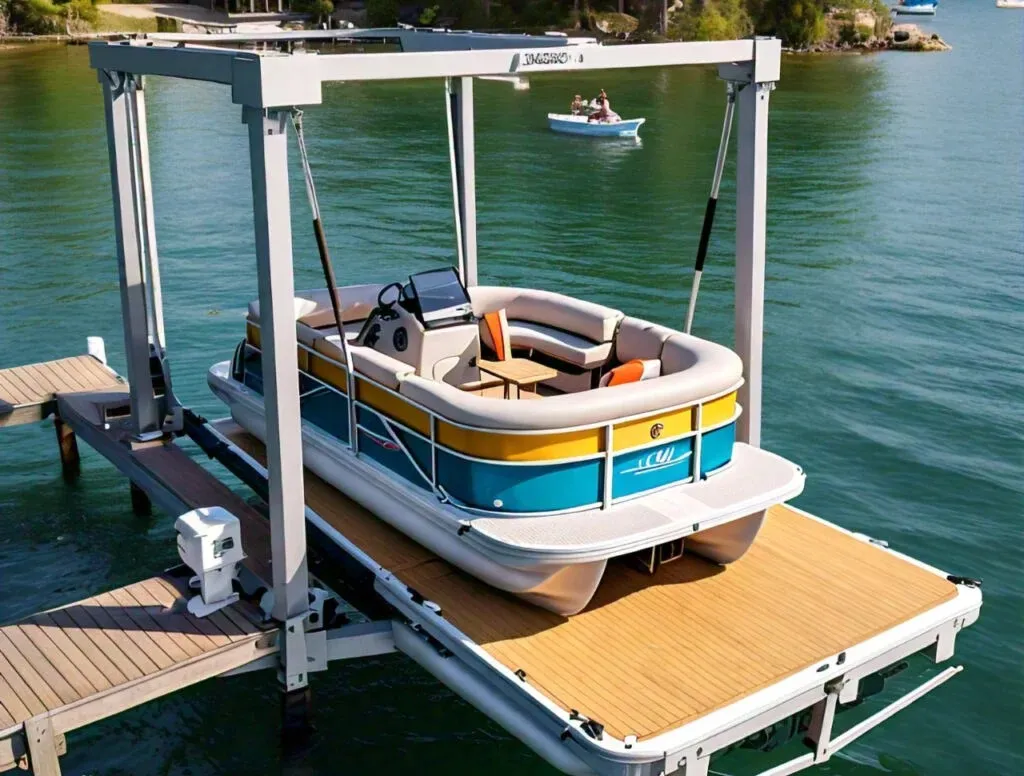
When it comes to protecting your pontoon, a pontoon lift is an essential investment. Not only does it protect your boat from the elements, but it also makes maintenance easier. In this guide, I’ll tell you everything you need to know about pontoon boat lifts, from the types available to tips for choosing the best one for your needs.
Why You Need a Pontoon Boat Lift
Owning a pontoon lift offers many benefits. Prevents your boat from damage due to fluctuating water levels, algae, and other water-related hazards. In addition, it simplifies boat maintenance by facilitating cleaning and repair of the hull.
Types of Pontoon Boat Lifts
1. Cantilever boat lifts
Cantilever risers are ideal for shallow water and provide excellent stability. They use a simple lever system to lift the boat out of the water. These elevators are durable and require minimal maintenance.
2. Hydraulic boat lifts
Hydraulic lifts provide the convenience of effortless raising and lowering with just the press of a button. They are suitable for different water depths and offer fast operation, making them a popular choice among pontoon owners.
3. Vertical boat lifts
Vertical lifts are versatile and can withstand significant fluctuations in water levels. They are designed to lift boats upward, making them suitable for both shallow and deep water.
4. Floating Boat Lifts
Floating lifts are perfect for areas where water levels fluctuate. These lifts rise and fall with the water, ensuring your pontoon boat is safe no matter the conditions.
How to Choose the Right Pontoon Boat Lift
Consider the size and weight of your boat
Make sure the lift you choose can support the weight and size of your pontoon. Check the manufacturer’s specifications to match your boat’s requirements.
Evaluate water conditions
Consider the depth of the water, fluctuation levels, and the type of water (saltwater or freshwater) where you will use the lift. Some lifts are better suited to specific conditions.
Evaluate durability and materials.
Look for lifts made from high-quality materials, such as marine-grade aluminum and stainless steel. These materials resist corrosion and provide long-lasting durability.
Ease of use and maintenance
Choose a lift that is easy to use and requires minimal maintenance. Hydraulic and floating lifts usually offer more comfort in this regard.
Budget considerations
While it is important to invest in a quality elevator, there are options to suit different budgets. Consider the long-term benefits and maintenance savings when making your decision.
Installation Tips for Pontoon Boat Lifts
Proper installation is crucial to the effectiveness of the pontoon lift. Here are some tips to ensure a smooth installation process:
- Follow the manufacturer’s instructions: Always refer to the manufacturer’s instructions for specific installation steps.
- Check local regulations: Be sure to comply with local regulations and obtain all necessary permits before installation.
- Professional Assistance: If you are not confident in your DIY skills, consider hiring a professional to install the elevator for you.
- Periodic Inspections: After installation, perform periodic inspections to ensure all components are functioning properly.
Maintenance Tips for Pontoon Boat Lifts
To extend the life of your pontoon boat, regular maintenance is essential. Here’s how to keep your elevator in top condition:
- Lubricate moving parts: Apply lubrication to moving parts regularly to prevent rust and ensure smooth operation.
- Inspect cables and pulleys: Check the cables and pulleys for signs of wear and replace them if necessary.
- Clean the riser: Remove debris and clean the riser periodically to prevent buildup that can cause damage.
- Winterize the lift: In colder climates, winterize your lift by removing it from the water or using a protective cover.
Benefits of Using a Pontoon Boat Lift
Using a pontoon lift offers several advantages:
- Damage Protection: This protects your boat from water damage and algae growth.
- Ease of maintenance: Simplifies cleaning and repairs by providing easy access to the hull.
- Extended Life: Extend the life of your boat by reducing exposure to harsh water conditions.
- Convenience: Makes launching and docking your boat easier and more convenient.
Conclusion
Investing in a pontoon lift is a wise decision for any pontoon owner. Protects your boat, facilitates maintenance, and extends the life of your investment. By understanding the different types of lifts, their benefits, and how to maintain them, you can ensure that your pontoon boat remains in excellent condition for years to come.
FAQs
1. What is the best type of pontoon boat lift for shallow water?
Cantilever lifts are ideal for shallow water due to their simple lever system and stability.
2. How often should I maintain my pontoon boat lift?
Regular maintenance should be performed seasonally, with lubrication of moving parts and inspection of cables and pulleys.
3. Can I install a pontoon boat lift myself?
Yes, but it’s important to follow manufacturer instructions carefully. If unsure, hiring a professional is recommended.
4. What materials are best for a pontoon boat lift?
Marine-grade aluminum and stainless steel are preferred due to their corrosion resistance and durability.
5. How do I winterize my pontoon boat lift?
In colder climates, winterize your lift by removing it from the water or using a protective cover to prevent damage.
 The Boat Journey
The Boat Journey
Leave a Reply